A lot of well-known pastors are promoting Lectio Divina, and many churches are taking that to mean that surely, this ancient prayer practice of emptying the mind is A-OK.
In his recent research article, Tim Keller promotes Catholic mystic, rejects Genesis 1 as literal truth, John Lanagan notes that Keller has advocated Catholic contemplative prayer practices. Here on YouTube Keller promotes Catholic mystic Teresa of Avila: Update: This video has been deleted.
Keller’s own website recommends the How-To of Lectio Divina. See for yourself here.
Update: This tutorial from Keller’s website has also been deleted: Many were alarmed when Keller’s webpage openly promoted Lectio Divina – “Divine Reading,” Instructions are given on how to practice Lectio Divina. A statement at the bottom of that page says the material is adapted from David Benner’s book, Sacred Companion. On a Recommended Resources page, linking off the lectio divina page, is a link to an article, “Meditation: Not so Mysterious” by contemplative teacher Jan Johnson (author of When the Soul Listens).
In fact, much of the prayer content on the original post has either been deleted or modified. But others have taken the trouble to capture the original content and make observations. Lighthouse Trails did so in 2009:
Redeemer Presbyterian’s Way of the Monk workshop is not an isolated incident at their church. On the website, there are several other indications: an article on meditation written by contemplative advocate and spiritual director Jan Johnson who talks in the article about lectio divina and Ignatius exercises.1 Ray Yungen discusses Johnson’s contemplative viewpoint in A Time of Departing:
Jan Johnson in her book, When the Soul Listens: Finding Rest and Direction in Contemplative Prayer, is a perfect example of an evangelical Christian who endorses and promotes this practice. She leaves no doubt about what this type of prayer entails:
Contemplative prayer, in its simplest form, is a prayer in which you still your thoughts and emotions and focus on God Himself. This puts you in a better state to be aware of God’s presence, and it makes you better able to hear God’s voice, correcting, guiding, and directing you.
Johnson’s explanation of the initial stages of contemplative prayer leaves no doubt that “stilling” your thoughts means only one thing; she explains:
In the beginning, it is usual to feel nothing but a cloud of unknowing…. If you’re a person who has relied on yourself a great deal to know what’s going on, this unknowing will be unnerving.
(ATOD, 2nd ed., p. 82)
This cloud of unknowing is from a book written by an anonymous monk centuries ago called The Cloud of Unknowing, a primer on mantra-type meditation.
Another instructive article on the Redeemer site called “Lectio Divina – “Divine Reading” is written by staunch contemplative proponent David Benner, author of Sacred Companions.2 And under leadership on their church website, Redeemer recommends Henri Nouwen’s book, In the Name of Jesus, where Nouwen says that Christian leaders must move from the “moral to the mystical.”3
In The Cloud of Unknowing, it states: “Take just a little word, of one syllable rather than of two … With this word you are to strike down every kind of thought under the cloud of forgetting.” In The Cloud of Unknowing, as with other contemplative authors, it says that this form of prayer will unite the soul with God. That is said because it is believed by mystics that God and man are one and that God dwells in all humanity and all creation–and through meditation, man comes to this realization that he cannot see without meditation. Thus, the fruit, if you will, of contemplative prayer is interspirituality and panentheism.
And herein lies the problem. As an increasing number of proclaiming Christian leaders and pastors move their followers toward this mystical spirituality wherein a word or phrase is repeated until a state of silence is reached (or that place of unknowing) or the breath is focused upon to gain the same results as the repeated word or phrase, the question must be asked and answered, is this a legitimate form of biblical meditation, or is it no different than transcendental meditation and Hinduism (with Christian spray paint) where the soul is said to be brought into unity with the Divine? We hope and pray that discerning Christians will study this matter and come to realize contemplative spirituality is a doctrine of demons (I Timothy 4:1), leading practitioners away from the true Gospel and toward an earthly deceptive gospel that says man is God.
If Tim Keller’s church continues to incorporate the way of the mystic, they will, in time, absorb the essence of mysticism if that hasn’t already even happened.
Lanagan further notes:
Incredibly, one of the authors on the church website is Jan Johnson, a well known spiritual director. In addition to lectio divina, her article even recommends the Spiritual Exercises of Ignatius of Loyola. [7] Ignatius was a fierce Catholic opponent of the Reformation.Contemplative prayer is really Eastern/New Age meditation, only coated with Christianese terminology. Unlike genuine prayer, where we communicate with our God, the goal in Eastern/new age/contemplative is to stop all active thought. In this silence, amazing and deceptive things can happen.
Contemplative practices can addle and alter theology. According to gotquestions.org, “Contemplative spirituality is an extremely dangerous practice for any person who desires to live a biblical, God-centered life.” [8]
Finally, our friend Ken Silva, who passed away in 2014, wrote this on Apprising Ministries in 2011:
TIM KELLER RECOMMENDING ROMAN CATHOLIC MYSTICISM
By Ken Silva pastor-teacher on Jan 27, 2011
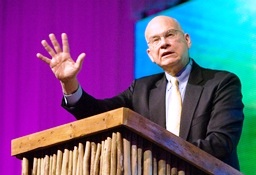 A while back Apprising Ministries told you that Rick Warren And Peter Scazzero Are Up To Monk-ee Business and also asked is: Tim Keller Endorsing Counter-Reformation Contemplative Spirituality? Briefly, Leadership Network’s propped up Purpose Driven Pope Rick Warren has actually been been up to spiritual monk-ee business for years now in opening the door for corrupt Contemplative Spirituality/Mysticism (CSM) ala Living Spiritual Teacher and Quaker mystic Richard Foster—and his spiritual twin Dallas Willard—within the mainstream of evangelicalism.
A while back Apprising Ministries told you that Rick Warren And Peter Scazzero Are Up To Monk-ee Business and also asked is: Tim Keller Endorsing Counter-Reformation Contemplative Spirituality? Briefly, Leadership Network’s propped up Purpose Driven Pope Rick Warren has actually been been up to spiritual monk-ee business for years now in opening the door for corrupt Contemplative Spirituality/Mysticism (CSM) ala Living Spiritual Teacher and Quaker mystic Richard Foster—and his spiritual twin Dallas Willard—within the mainstream of evangelicalism.
You need to understand that this spurious CSM is basically reimagined Roman Catholic mysticism allegedly “discovered” by Foster, and now perpetrated within the mainstream of evangelicalism as supposed Spiritual Formation—with an able assist from his running mate Willard; both were key mentors of the sinfully ecumenical neo-liberal cult of the Emergent Church aka the Emerging Church. CSM was a core doctrine in the EC right from its hatching in Hell and plays a large part in the development of its postmodern Progressive Christian theology—a Liberalism 2.0—that they often refer to as “big tent” Emergence Christianity.
The truth is that the very rotten core practice of this CSM is Contemplative/Centering Prayer (CCP), which is sometimes referred to as practicing “silence and solitude” or by the ridiculous moniker “wordless prayer”; but it’s actually a type of meditation in an altered state of consciousness that’s virtually identical to that practiced in Eastern religions such as Zen Buddhism and the transcendental meditation of Hinduism. And yet this kind of spurious spiritual formation—so-called “Christian” mysticism, which really developed in the antibiblical monastic traditions of apostate Roman Catholicism, is now showing up in more and more evangelical churches.
With this in mind, in recent posts such as Acts 29 Network And Reformed Counter Reformation Spirituality? and Acts 29 Pastor Matt Chandler On Being A Reformed Charismatic I’ve shared some concern about so-called New Calvinism, which itself appears to be a postmodern form of Calvinism embracing both Reformation theology and the Counter Reformation spirituality of CSM. While openly recommending Foster-Willardism seems new, here you’ll see evidence from Tim Keller, one of New Calvinism’s most respected spokesman, that he was encouraging CSM at his Redeemer Presbyterian Church (RPC) circa 1998 around the time the EC was launching.
Back in September of last year in her post “The Way of the Monk” Class Schedule – Redeemer Presbyterian Church by Christine Pack* of Sola Sisters* provided screen shots of the class schedule for something called The Way of the Monk at RPC put on April 28, May 5 & 12 of 2009 by Susan Castillo, who told us she likes “to embrace her ‘inner monk,’” where we supposedly would have been taught to have great theology become more real:
The first class was on CCP, meditation in an altered state of consciousness:
So we “long for the great theology in [our] head to be more real to [our] heart”; this begs the question: If one is actually in line with the theology of the Protestant Reformation, why then turn to apostate Roman Catholics to discover highly subjective experiences in CSM when the Reformers rejected it in favor the proper Biblical spirituality of sola Scriptura? Yet—even though this is no longer on the RPC website—you’ll see above, the May 5 session was on:
Prayer Rope
Finally…help for fidgety hands and distracted minds! In this session, we will focus on the use of a prayer rope, a practice of prayer that engages the whole person. We’ll begin by viewing a brief video that demonstrates the “Chaplet of the Divine Mercy,” a particular method of using a prayer rope. We will then do our own investigation of Scripture to determine the meaning and power of God’s “mercy” and the resulting implications for rich, yet highly accessible intercessory prayer. We’ll also cover history, purpose, technique, and devote ample time to actual practice and Q &A. (Online source)
Now you’re about to see Dr. Keller himself taught Roman Catholic mysticism to RPC long ago. The following comes from a series called Gospel Spirituality-MCM:
As you can also see in Meditation What it is? , “This talk was given during a leadership training session at Redeemer Presbyterian Church in New York City” October 5, 1998:
I do wish to say that Dr. Keller’s definition of meditation, with “[i]ts essence [being] reading and reminding ourselves of the truths of God while dwelling in his presence, is adequate despite the Brother Lawrence-like dwelling in God’s presence. He’s responsible of the book The Practice of the Presence of God; however, the idea of “practicing the presence of God” is meaningless. Do we also practice the omniscience of God; or perhaps, we need to practice His omnipotence? You may recall that in Disciplines To Deception In The Southern Baptist ConventionI told you about this gentleman; you see, “Brother” Lawrence (born Nicholas Herman) was a mystic Roman Catholic monk; in fact, Lawrence was of the “Carmelite order mean[ing] his spiritual practices were derived from or heavily influenced by Teresa of Avila.”[1]
Dr. Keller tells us he’s talking about “levels of prayer,” by which he means “going far deeper into the presence and the reality of God.” Then sounding a bit Gnostic he explains that, “The reason that [meditation] is so critically important is because it is the gateway to prayer—to real prayer. To prayer that gets beneath the surface.” Rather odd that Jesus never taught contemplative/centering prayer; nor did His Apostles, so were they not able go deeper into the presence of God to real prayer? Where do you suppose Dr. Keller derived some of his views; he’ll tell you by a certain Quaker mystic and the usual suspects when the subject of Roman Catholic mystics comes up:
we’ve got at least two other streams of that are filled with good, helpful material on meditation – the Catholic stream and the Quaker stream that are not primarily based on meditating on the Scripture. There are a number of reasons why. But just to give you an example, I read a book by a Quaker—ah actually the book is great, except for one part. Some of you have heard of him. His name is Richard Foster. He wrote the book called Celebration of Discipline. (23:27-23:57)
Here’s Dr. Gary Gilley’s take on Foster’s “great” book Celebration of Discipline, which he refers to a virtual encyclopedia of theological error:
Celebration of Disciplinealone, not even referencing [Richard] Foster’s other writings and teachings and ministries, is a virtual encyclopedia of theological error. We would be hard pressed to find in one so-called evangelical volume such a composite of false teaching. These include faulty views on the subjective leading of God (pp. 10, 16-17, 18, 50, 95, 98, 108-109, 128, 139-140, 149-150, 162, 167, 182); approval of New Age teachers (see Thomas Merton below); occultic use of imagination (pp. 25-26, 40-43, 163, 198); open theism (p. 35); misunderstanding of the will of God in prayer (p. 37); promotion of visions, revelations and charismatic gifts (pp. 108, 165, 168-169, 171, 193); endorsement of rosary and prayer wheel use (p. 64); misunderstanding of the Old Testament Law for today (pp. 82, 87); mystical journaling (p. 108); embracing pop-psychology (pp. 113-120); promoting Roman Catholic practices such as use of “spiritual directors,” confession and penance (pp. 146-150, 156, 185); and affirming of aberrant charismatic practices (pp. 158-174, 198). (Mysticism – Part Two)
I guess other than that it’s a good book; as I close this out, for now, Dr. Keller also tells us that Foster has written another “book called Meditative Prayer and it’s very typical of the Quaker tradition.” He also shares, “The best things that have been written almost are by Catholics during the counter Reformation—Ignatius Loyola, Francis de Sales, John of the Cross, St. Teresa of Avila—great stuff.” Dr. Keller then continues on:
Meditation is sensing with the mind instead of just thinking. Here’s what I mean – if I read a passage and I say, ‘that means that, that means that, that means that,’ I’m thinking. But if I read a passage and I say, ‘that’s sweet’ or ‘that hurts’ or ‘that’s beautiful.’ What am I doing? I’m using sensory language. I’m talking about seeing even though I’m not seeing anything. I’m talking about hearing. I’m talking about tasting. In other words, by letting your heart sense the truths rather than simply understanding them you’ve begun to meditate. Meditation is to bring the truth in contact with the heart until the Triune God becomes so real to you that you seek Him with all your being. (32:44-33:28)
Here’s something to meditate on: If meditation is to bring the truth in contact with the heart so that you seek God with all your being, then how is it these vaunted Roman Catholic mystics never discovered the actual Gospel of Jesus Christ—salvation by God’s grace alone, through faith alone, in the finished work on the Cross of Christ alone—and remained servants to apostate Roman Catholicism, which Dr. John MacArthur rightly stated is, “Satan’s best front for the Kingdom of God.”
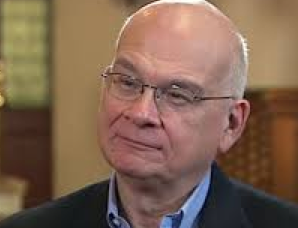
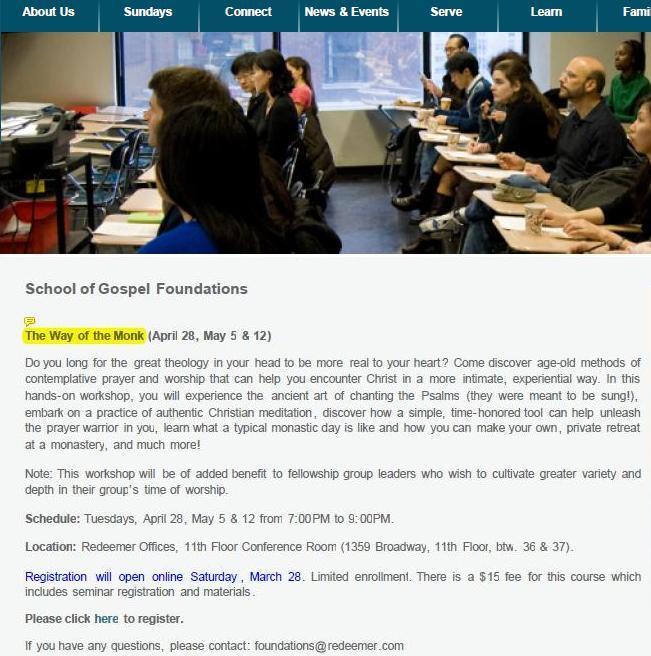
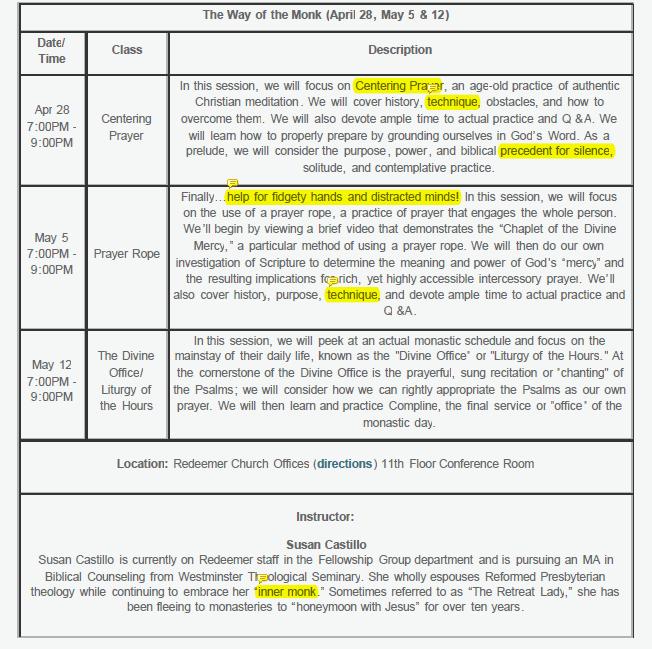
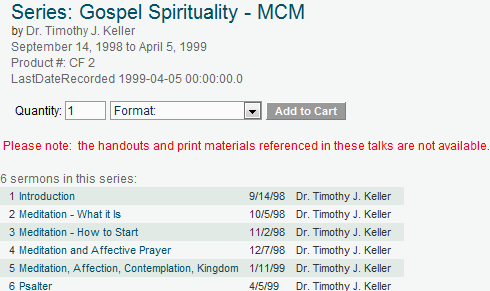




the desert fathers get blamed for this stuff, but the original contemplative prayer was to pray the psalms, contemplate something in the Bible or Jesus Himself, not the far eastern metaphysic kind of meditation. silencing the mind was about stopping the distractive thoughts that interfere with prayer and self examination. lectio divina was about reading The Bible so as to put it in practice.
medieval roman catholic monasticism developed these other style things in overreaction to the dry rationalism of scholasticism. the presence of this warped version is probably what made rcc susceptible to charismaticism. and the charismatics now are drawing on this to make even more of a trainwreck of rcc than it is already while evangelicals worry about selling out to rome, it is whatever left right in rome selling out to the deception in evangelical and charismatic errors!
I am a convert to Eastern Orthodoxy from Protestantism, and speak from that perspective. I have no preference for rome in making the foregoing statement. those in the new apostolic reformation which is definitely imperialistic minded cloaked in a Christian veneer, would be looking to take over rome and use it as a power bloc to their advantange.
https://en.m.wikipedia.org/wiki/Desert_Fathers
“Hesychasm (from the Greek for “stillness, rest, quiet, silence”)[18] is a mystical tradition and movement that originated with the Desert Fathers and was central to their practice of prayer.[19][20][21] Hesychasm for the Desert Fathers was primarily the practice of “interior silence and continual prayer.” It did not become a formal movement of specific practices until the fourteenth century Byzantine meditative prayer techniques, when it was more closely identified with the Prayer of the Heart, or “Jesus Prayer.”[22][23] That prayer’s origin is also traced back to the Desert Fathers—the Prayer of the Heart was found inscribed in the ruins of a cell from that period in the Egyptian desert.[24] The earliest written reference to the practice of the Prayer of the Heart may be in a discourse collected in the Philokalia on Abba Philimon, a Desert Father.[25] Hesychast prayer was a meditative practice that was traditionally done in silence and with eyes closed—”empty of mental pictures” and visual concepts, but with the intense consciousness of God’s presence.[26]
The words hesychast and hesychia were frequently used in 4th and 5th century writings of Desert Fathers such as Macarius of Egypt, Evagrius Ponticus, and Gregory of Nyssa.[27] The title hesychast was used in early times synonymously with “hermit,” as compared to a cenobite who lived in community.[23] Hesychasm can refer to inner or outer stillness, though in The Sayings of the Desert Fathers it referred to inner tranquility.[28]”
“The lives of the Desert Fathers that were organized into communities included frequent recitation of the scriptures—during the week they chanted psalms while performing manual labor and during the weekends they held liturgies and group services. The monk’s experience in the cell occurred in a variety of ways, including meditation on scripture.[30][31] Group practices were more prominent in the organized communities formed by Pachomius.[8] The purpose of these practices were explained by John Cassian, a Desert Father, who described the goal of psalmody (the outward recitation of scripture) and asceticism as the ascent to deep mystical prayer and mystical contemplation.[28]”
If you cannot see the parallels to Eastern mysticism, religion, thought and practice please open your eyes. Asceticism and withdrawing from society will not make you pious, if anything it will preclude the Great Commission.
Tim Keller and his TGC, and anything, anyone to do with him or his ‘coaltion,’ or anyone who supports him or his ‘coalition, should be avoided like cancer. Here you have the enemy in plain sight. Right in front of your eyes. be warned.
That is patently, irredeemably absurd.
Lectio Divina is simply a way to study the bible. You pick a verse and then you read it a number of times, picking out the words or phrases that the Holy Spirit draws your attention to. Then you read again and reflect on the greater meaning of the text, using your senses and emotions, Finally, you read again and ask God what is he saying to you in this bible text and how does he want you to apply it to your life. I have had amazing times with God using this simple method of bible study. It has nothing to do with Eastern religions or new age techniques. It is simply spending time with God. I’m sorry you have misunderstood this wonderful type of bible study because I’ve seen it transform many people’s life.
That is occultic in essence and in practice, Jesus taught how to pray and warned of repetition as the pagans did when praying to demons.
Matthew 6:7-8
7 “And when you pray, do not heap up empty phrases as the Gentiles do, for they think that they will be heard for their many words. 8 Do not be like them, for your Father knows what you need before you ask him.”
Why alter the simplicity and sufficiency if Jesus prayer?
I agree with Gwen. Anyone who condemns Lectio as New Age is way off track.
“eastern metaphysic kind of meditation. silencing the mind was about stopping the distractive thoughts that interfere with prayer and self examination”
Isaiah 2:5-2:6
“5Come, house of Jacob, and let us walk in the light of the LORD. 6For You have abandoned Your people, the house of Jacob, Because they are filled with influences from the east, And they are soothsayers like the Philistines, And they strike bargains with the children of foreigners.
Biblical prayer does not require “quietness”, “mindfulness”, “trance” “circles” or any other form of mystic practice. Jesus himself taught us how we should pray, and The Holy Spirit intercedes for us with groans we don’t understand:
Romans 8:26-27
26 In the same way, the Spirit helps us in our weakness. We do not know what we ought to pray for, but the Spirit himself intercedes for us through wordless groans. 27 And he who searches our hearts knows the mind of the Spirit, because the Spirit intercedes for God’s people in accordance with the will of God.
It is the work of The Spirit, not man in any way.
For those wishing to understand the origins of mindfulness, circle praying, the void, and repetitive prayer………Compare Taoism and Buddhism, this was always eastern mysticism, it was adopted by early mystics and made its way through the Roman empire. Sufism has the same practice, emptying, trancing, closer to “God.” The fact that these ancient occult practices have the same purpose in mind shows how correct Genesis is, the human diaspora brought this wherever man settled, from shamanism to the polished Lectionary Divina.Jesus put an end to this when He takes but us to pray correctly.
Today it affects churchianity as it melds back to Rome.